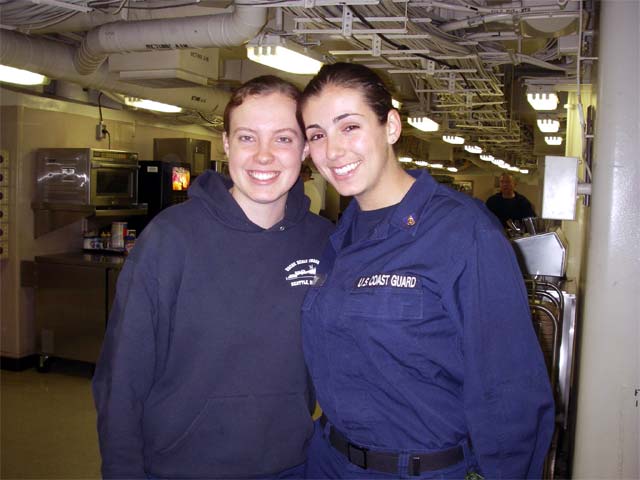( Log In ) Log In is for TREC Teachers & Researchers only
  |
| JayCee |
 May 31 2006, 06:59 PM May 31 2006, 06:59 PM
Post
#1
|
|
Unregistered |
Hey, Sam
From a teacher's perspective, tell us about the Coast Guard cadets onboard the Healy with you. -How old are they? -Where are they from? -What are their majors? -What do they do on the ship? -Is it obvious that they are students and not regular crew? I think the summer experience for the cadets must be incredible, since they are seeing the scientific studies as well as the handling of the ship Thanks |
| Samantha_Dassler_Barlow |
 Jun 2 2006, 08:57 PM Jun 2 2006, 08:57 PM
Post
#2
|
 Advanced Member    Group: TREC Team Posts: 99 Joined: 12-April 06 Member No.: 23 |
Dear JayCee,
Thank you for your questions about the cadets. They allowed me to meet with them tonight after dinner so that I could ask them questions. There are 2 female cadets on board the Healy with us from the U.S. Coast Guard Academy in New London, Connecticut. They are here to gain practical experience while they complete their college degrees at the Academy. I noticed the two of them not long after being on the ship and throughout the cruise I learned bits and pieces of information about them. They are a little shy, maybe uncertain sometimes, and don’t seem to have that edge of experience that most of the crewmembers seem to have. I don’t know if a normal person would notice that sort of thing, though. I was glad to sit down and talk with them for a few minutes to learn more about their experience on the Healy.  3/C Meaghan Geis (left) and 1/C Caroline Dayton pause for a picture after I finished interviewing them. They are Cadets at the U.S. Coast Guard Academy in New London, Connecticut, on summer assignment aboard the USCGC Healy. 1/C Caroline Dayton is 20 years old and she is originally from West Hartford, Connecticut. (1/C stands for First Class Cadet.) She is in between her junior and senior years of college and is majoring in mechanical engineering. She spends most of her time shadowing junior officers on the Healy and occasionally works on small projects that they assign to her. She has qualified to be the Junior Officer of the Deck (JOD) while she stands watch on the bridge and she is working on breaking in as an Officer of the Deck (OOD). The JOD takes care of the logs and the OOD is in charge of driving the ship during a 4-hour watch on the bridge. Caroline’s collar devices indicate that she is a cadet to others and they have a blue background, so people often call her the “blue cadet.” Caroline spent her 3rd class experience on board a “white-hull,” a 378 foot, high endurance, law enforcement vessel out of Honolulu called the Rush. She was on the only USCG boat that participated in a large war game training exercise with many different countries from around the pacific. Caroline hopes to be assigned to a white-hull doing law enforcement and search and rescue operations in the southeastern part of the United States when she finishes at the Academy. 3/C Meaghan Geis is 18 years old and she is originally from Maryland. She is in between her freshman and sophomore years of college and is majoring in marine and environmental science. She spends most of her time shadowing enlisted personnel. Since both cadets will be commissioned officers (Ensign) when they graduate, it is important for them to spend time getting to know the jobs of the enlisted personnel. Meaghan also stands watch on the bridge and is qualified for the position of JOD, but she is also standing watch in the main control space for engineering where she helps monitor the engines on the computer screens and makes rounds to check the engineering spaces. In the future, she hopes to maybe be a Marine Science Officer on board an icebreaker or to a buoy tender on the West Cost and is excited about the prospect of traveling to new places that are different and far from the ones she is used to back home. When I asked about their science experience, they told me that most of it comes from standing watch on the bridge with a view of the fantail from the camera mounted on aftcon at the stern of the ship. From their perspective, it is important that the ship gets positioned on station and stays adrift within a one-mile radius of the station in conditions clear enough to lower the science sampling equipment into the water. They know the order of the series of instruments that go overboard pretty well and they could even tell me a little bit about those six instruments. Of their experience on board the Healy, the cadets both told me that people know they are cadets and that they are here to learn so they go out of their way to help. |
  |
2 User(s) are reading this topic (2 Guests and 0 Anonymous Users)
0 Members:

|
NSF Acknowledgment & Disclaimer | Time is now: 3rd November 2024 - 12:50 PM |
Invision Power Board
v2.1.7 © 2024 IPS, Inc.








